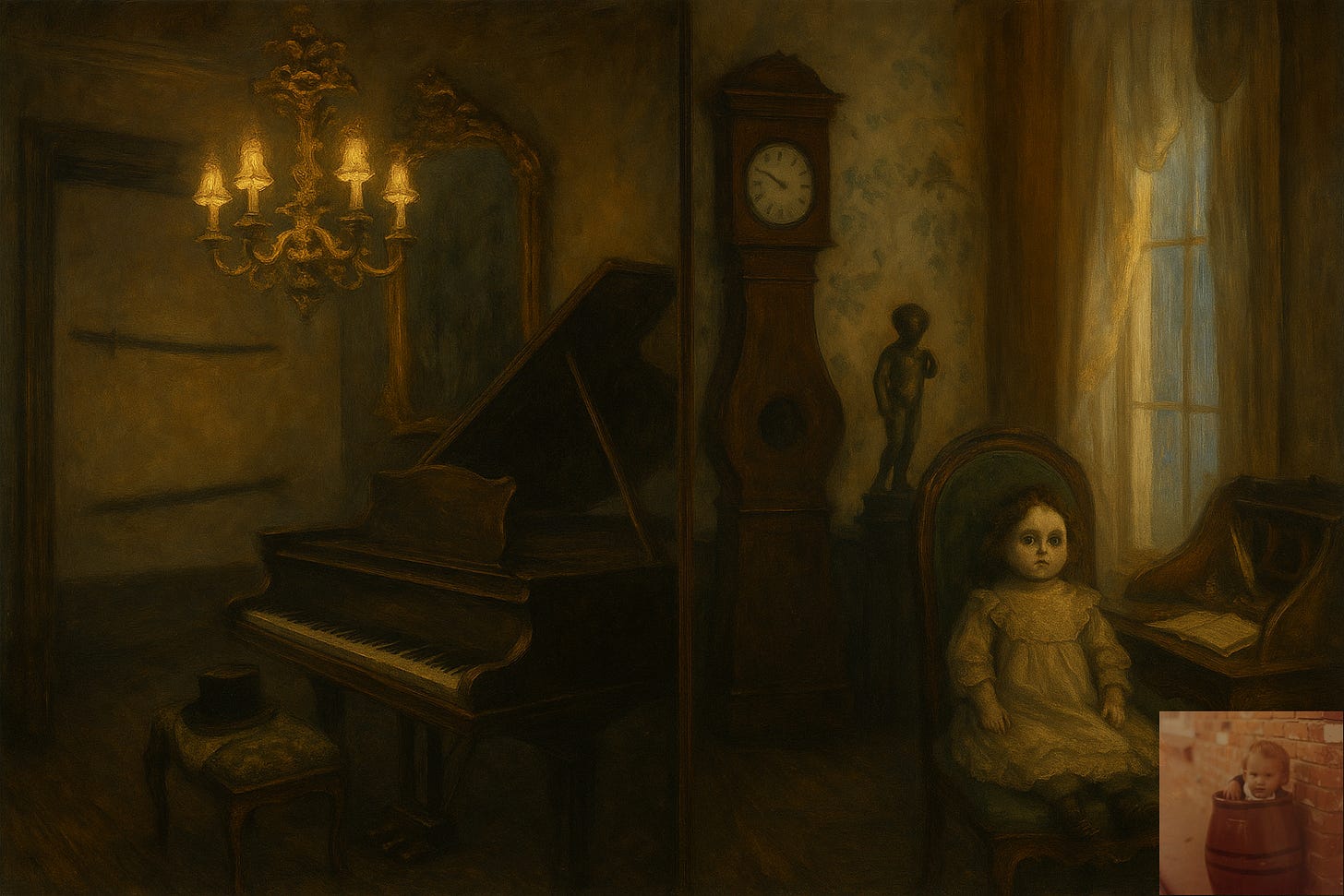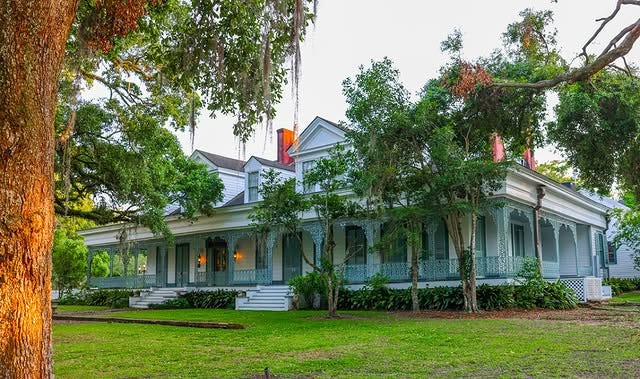Part I: The Stillness
Yesterday and further back (time folded on itself)
The pond was the color of old glass—green with a tint of blue, a hue you can’t mix, only inherit. In 2020 and now, I walked across the little footbridge, the air hushed and heavy, the kind of quiet that feels awake. The gazebo stood then on the small islet at the center, white and slightly crooked, like something the house had dreamed into being. (It had to be moved in 2024 after storm damage.)1 The low wooden chairs that remain on the spot seem fixed and content.
Across the water, a small raft made of logs used to drift near the island. Now it’s tied to the opposite bank, still loyal to the pond that has stopped moving but not stopped breathing. Sound doesn’t carry here; it folds back on itself. Voices from the house dissolve before they reach this side.
Cabins rim the pond, their porches half-hidden by ferns. Closer in, behind the restaurant, the inn keeps its lights low. Across the courtyard sits the Elta café, sharing its open floor with the gift shop. The porch swing has been brought indoors, facing a couch where travelers sip coffee and watch the rain collect on the windows.
I ordered an oat milk cappuccino and sat there, half in 2020, half in childhood. Chickens wandered the courtyard like they owned the place. Ducks circled the pond, indifferent and content. Up by the long drive, two goats huddled under their shelter, soft silhouettes behind the fence.
Part II: Into The House
And there it was again—the scent. Cypress wood, warm and damp and unmistakable. The smell of the house itself, its truest voice.
It hit me before I realized the memory it carried. It was the same breath I’d felt decades ago, walking into the main hall for the first time. The scent of wood that has learned to remember.
I’d done the day tour decades ago, but this was my first time seeing the Myrtles at night. A rainy day with a docent called Rainy Day.
Our guide, Rainy Day—real name, she swears, birth certificate to prove it—wore a swishy Southern-belle dress as she told tales entirely incongruous with her warm demeanor. Her warmth gave balance to the chill inside the house, as necessary for preservation as the discreetly humming dehumidifiers.
In her pleasant, conversational way, she sanded the sharp edges off horrors that might otherwise splinter the air: an ear cut off in punishment, a man shot, a child taken by yellow fever—half her small body already stiffening, even in the portrait that still hangs in the card-table room.
Most of our group stayed quiet, as I did, wary of disturbing whatever still lives here—hoping even small movements wouldn’t be mistaken for disrespect. Yet every haunted-house tour seems to invite at least one or two childish provocateurs, eager to poke the beast. For them, Rainy’s warning became a dare when she pointed toward a doorway she called a portal—a place, she said, where visitors had felt unseen hands brush their arms.
The “portal” links the ladies’ sitting room to the gentlemen’s. In the latter, my eyes went straight to the bookcase. I tried to read the titles on the tomes—was that a full set of Waverley?—before being informed that someone had been shot in that spot. A book by Troy Taylor and David Wiseheart explains that there are at least ten murders according to legend which happened on the Myrtles property, but only one can be verified. It was in that room—the gentleman’s parlor—where the shot struck William Winter in 1871, who collapsed onto the side gallery. Someone stood trial, but the murder was never solved.2
The air there seemed denser, as if the room were still holding its breath.

Part III: Determination
There’s only one word for the story Rainy told in the small room just off the main entryway: determination.
It’s called Chloe’s Room, apparently—a refuge for porcelain dolls arranged along the mantel like quiet witnesses. One of them, legend claims, has a face that distorts itself in phone photographs—features blurred or rearranged by something that doesn’t want to be exploited.
But that isn’t the story Rainy emphasized.
She spoke instead about the test. To become a docent at the Myrtles, she explained, one must spend a night alone in the house. She was already working there in another role, but she wanted to give tours—to speak for the house itself. So she chose this room.
When she shut the door behind her, the chandelier began to spin. Not sway, not tremble—spin, slow and deliberate, like the second hand of a clock that had just remembered time. Thinking it must be mechanical, she called a coworker for help.
“What do you mean, Rainy? The chandelier doesn’t spin.”
That’s when she realized she was not alone after all.
Ashley Rovira, for one, would never have stayed in a room where the chandelier was spinning.
But Rainy Day is not Ashley Rovira.
Rainy Day wanted to be a docent at The Myrtles like Ashley just wants to read books and write things on Substack.
And by dawn, when the chandelier ceased its rotary amusement, Rainy earned the right to tell the house’s stories in her own calm, luminous way.
Part IV: The Mirror, the Legs Under the Table, the Stiff Child, and Other Creepy Things
Everyone who knows haunted lore knows about the mirror. It’s introduced without ceremony, as if its reputation walks ahead of it—the most haunted piece of furniture in America, they say, and no one bothers to argue.
The caretakers do what they can to preserve it. But there’s only so much you can do to a mirror that, once wiped clean, re-smudges itself. The same marks return, within hours, fingerprints where no hands have been. Like the house that shelters it, the mirror doesn’t want to be pristine. It only wants to be.
Elsewhere, the hauntings hide in the details: the legs under the dining-room table that appear only in digital photographs, the sword that once hung above the mantel when I was a child and now rests across a side table in the card-room. Over it hangs the portrait of a Confederate soldier—expression fixed, eyes flat, the kind of painting that watches back.
Two other portraits hold court in that same room of games: a man whose eyes do not leave you, and a girl—about three years old—whose small body shows the unmistakable signs of rigor mortis. Her name was Kate. She died of yellow fever, yet the portrait painter, as was apparently common practice, was obliged to continue his work. Her likeness, finished after death, seems to have fused with the vibration of the house itself.
Rainy Day told us there are more soldiers on the property, buried somewhere beyond the fence line in a mass grave. No markers, no names. The site was deliberately obscured, she said, after too many YouTubers came hunting for bones.
The sword, the portraits, the mirror: objects that seem to know the human weakness for reflection, for proof. They wait, patient and unblinking, for someone to mistake evidence for understanding.
Notes: I decided not to publish the few photos I dared to take inside the house. As exploited as the house has been for decades, my own choice is to not participate in that exploitation. I realize The Myrtles is a huge business that runs on humans’ endearing fascination with the afterlife, that the hotel and the restaurant and the cafe all thrive on the perpetuation of its spooky legends. Photographs are allowed inside the house as long as you don’t use the flash. It’s just a personal preference, born of a respect for the silence that endures there. I will, however, share with you my YouTube playlist of the walking tour I took of the grounds in 2020. If you would be so kind as to subscribe to my YouTube channel, I would be eternally grateful.
YouTube @heavycrownpress (The Myrtles Playlist)
You can learn a lot more about The Myrtles in St. Francisville, Louisiana at their website (www.themyrtles.com) or by following them on Instagram @the_myrtles.
{https://share.google/QZpUKqK5yECu009GX} {https://www.wafb.com/video/2024/04/11/damage-myrtles-plantation-part-1/}
{https://web.archive.org/web/20131029235907/http://www.prairieghosts.com/myrtles.html}


